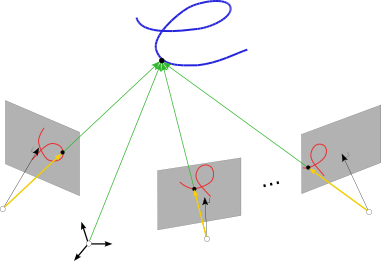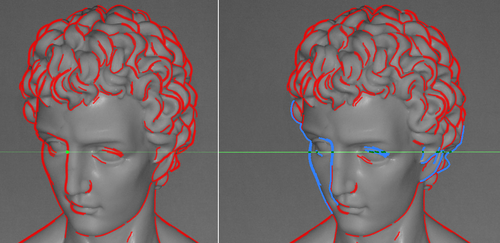Research on Multiview Differential Geometry of Curves and Surfaces
Ricardo Fabbri and Benjamin Kimia
This project proposes a paradigm shift for 3D reconstruction from multiple perspective projections, based on differential geometry. We have been developing a new framework to model curved structures on both space and time, including general non-planar curves, surfaces, shading, curvilinear camera trajectories, and nonrigid motion.
State-of-the-art camera calibration and 3D reconstruction systems are based on very sparse point features, such as SIFT, and projective geometry, which can only model points and lines or simple curves such as circles and other conic sections. These systems suffer from many of the following limitations: sparsity, requirements of simple scene, controlled acquisition, difficulty with non-planar objects, requirement of strong calibration, abundant texture, short baselines, and lack of geometric consistency. We believe these systems are useful but form only a module within a greater structure from motion system.
Given two or more views of a fixed space curve, in 2004 we have shown how the torsion of the curve can be reconstructed from image measurements (pdf). Two views are necessary and sufficient, and more than 3 views provide an over-constrained solution. This initial study has opened an entire new line of research, where we have extended these results to most types of contours (rigid, occluding, nonrigid), and have been modeling many other problems involving curvilinear phenomena in the geometry of multiple views, including camera auto-calibration from tracked curves, the use of surface patches and their shading under different illumination models, and fields of both short and long curve fragments for multiview applications.

We are also working on a practical and comprehensive application for automatically reconstructing complex 3D objects from a sequence of images, and have completed many modules. One of our systems is based on image curve fragments as obtained from a subpixel edge linker. A simple step in corresponding curve fragments in two views is shown in the following figure, where the epipolar lines are in green:

Check out the website for Multiview 3D Drawings for a recent implementation presented at ECCV'16 and CVPR'17. See also CVPR'20 paper on the trifocal pose estimation modules.
A curve-based reconstruction has many advantages over point features:
- Curves are dense, and their geometric consistency allow for meaningful and recognizable multiview reconstructions of complex scenes, as compared to point clouds.
- Curves are intimately related to the geometry of the underlying surface, being useful in practice as a reliable constraints for surface-based reconstructions of general scenes.
- Curves as are strongly invariant to illumination.
We tackled the challenges of using linked curve fragments, namely the instabilities in linking and correspondence in the 3D Drawing system. The practicalities around nonrigid curves (e.g. occluding and other nonrigid), the trifocal bootstrapping of the system, and the surfacing of 3D Drawings are currently active topics.
Publications
(updated list available at Fabbri's home page)- Camera Pose Estimation Using Curve Differential Geometry, IEEE Transactions on Pattern Analysis and Machine Intelligence - PAMI, 2020, with Peter J. Giblin & Ben Kimia (pdf | code) new!
- Trifocal Relative Pose from Lines at Points and its Efficient Solution, CVPR 2020, originally published online march 23 2019 4:29 UTC, with Tim Duff, Hongyi Fan, Margaret Regan, David de Pinho (my former MSc. Student), Elias Tsigaridas, Charles Wampler, Jonathan Hauenstein, Peter Giblin, Ben Kimia, Anton Leykin and Tomas Pajdla (pdf |
code | datasets)
accepted! won an award: NSF Research Institute Highlight
- The research led and mentored by Fabbri (with close leadership by his former advisor Ben Kimia at Brown) have been spawning a number of notorious works, including an award-winning paper at CVPR 2019 (Duff, Kohn, Leykin, Pajdla) which Fabbri pioneered while at ICERM and can be considered an honorary last author. Fabbri's interest is in pushing the results beyond points and straight lines, while using sophisticated machinery of Projective Differential Geometry and nonlinear PDEs for building fast and robust algorithms. -- September 2020
- The Surfacing of Multiview 3D Drawings via Lofting and Occlusion Reasoning, CVPR 2017, with Anil Usumezbas & Ben Kimia, Expanded version available (pdf | poster | datasets | website | bib)
- Multiview Differential Geometry of Curves,
International Journal of Computer Vision, 2016, with Ben Kimia. (pdf | code | bib)
- The main result is the reconstruction of torsion and curvature derivative of a space curve from multiple perspectives, a fundamental theorem I proved in 2004. This paper is the outgrowth of that effort, including continuous motion, non-rigid scenes, intrinsic parameters and camera estimation from occluding contours. It is the seed for a monograph I've been writing, a kind of an extended Hartley & Zisserman's book for general curves and differential geometry. For instance, if you need to reconstruct orientations from two or more views (SIFT orientations or other vector fields, including curvature and torsion fields), this is the place to go.
- From Multiview Image Curves to 3D Drawings, ECCV 2016, with Anil Usumezbas & Ben Kimia, Expanded version available (pdf | supplement | code | datasets | website | bib)
- Camera Pose Estimation Using Curve Differential Geometry, Updated and published into PAMI 2020!, ECCV 2012, Firenze, Italy, with Peter J. Giblin & Ben Kimia (pdf | code | bib)
- Multiview Differential Geometry in Application to Computer Vision, my Ph.D. Thesis, School of Engineering, Brown University, 2010. Partly superseded by the above papers, still has valuable insight (pdf | bib)
- 3D Curve Sketch: Flexible Curve-Based Stereo Reconstruction and Calibration, CVPR 2010, with B. Kimia. The practical basis of the 3D Curve Drawing work above (pdf | poster | code | website | bib)
- High-Order Differential Geometry of Curves for Multiview Reconstruction and Matching, EMMCVPR 2005, Lecture Notes in Computer Science, 3757, pp. 645-660, 2005, with B. Kimia. A new theorem on recovering torsion of a space curve from multiple perspectives, please refer to my IJCV'16 paper (original | corrected)
<< home << 3D Drawings